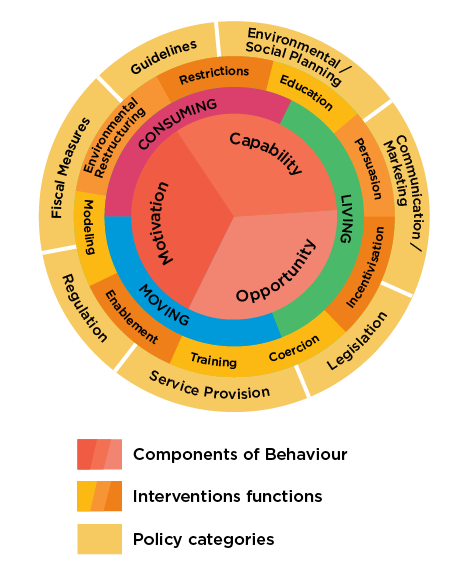Recommendation: Enable and encourage people to change their behaviour for triple-win impacts
Our unsustainable behaviours, shaped by prevailing political and economic models and structures, impact our health and the health of our planet, as well as social cohesion and equity. Although changes in how people choose and are enabled to live, move and consume is a key aspect of transitioning to more sustainable societies, behaviour, and its underlying mechanisms, is insufficiently considered by policies seeking to mitigate the climate crisis and address ill-health. Policymakers have a crucial role in encouraging and enabling everybody – as individuals and as professionals – to make sustainable positive changes, and in building a social and physical environment that facilitates these changes, benefiting health, equity and the environment. Evidence from INHERIT highlights that whilst it is difficult for people to adopt new behaviours in the areas of living, moving and consuming, it can be done when they are provided with the opportunity to change, and are supported in increasing their capability and motivation.[1]

Voices from INHERIT
Voices from INHERIT
Consuming: Around half of the survey respondents would find it easier to follow healthy and sustainable diets if the price of fruit and vegetables was lower and the price of foods high in sugar and salt was higher.
Living (energy efficiency): “Compared with the current life similarity is the intention of saving, to have energy efficient homes, but the opportunities are limited, do not enable us to save. We know that we would have saved much more if we use solar panels, but we don’t have them. One thing are the capabilities and what we know, other is what we do. Today we spend more energy than we need.”
Moving: “I like the rewarding of all traffic participants who will use public transport, bicycle or who will go by foot. The use of cars would be more expensive. The companies would stimulate the health insurance for benefits for citizens who will use the alternative way to commute.”
Living (green spaces): “Some opportunity for tree climbing or climbing somewhere high, like a climbing wall. I would like these. More playgrounds focused on sport, also meant for adults.”
What can be done? Insights from INHERIT
What can be done? Insights from INHERIT
Examples
Examples
INHERIT triple-win case studies
More information on the INHERIT case studies can be found in the Annex: triple-win case studies
Sustainable Food in Public Schools
Motivates kitchen staff by providing education and training on healthy sustainable food for children, engaging them in the process of positive change. Assessed as economically beneficial (the potential benefits exceed the costs in a ratio of approximately six to one).
STOEMP
An integrated city approach to ensure healthy sustainable food to low-income populations. Demonstrates how different sectors and organisations can work synergistically together to implement actions towards healthy eating, and aims to bring people together around food.
Urban Cyclers
Motivates app users to engage in regular cycling through a combination of cycling maps, route planner, turn-by-turn navigation, smart gamification features and financial incentives.
GemüseAckerdemie
Provides children with the opportunity to connect with nature and learn about growing food, through an education and training programme for teachers.
Lifestyle e-coaching
Motivates users of a lifestyle app to engage in physical activity. Targets disadvantaged populations, and is particularly effective in those with low-levels of initial activity.
INHERIT Promising practice database
Questionmark
IT tool (website and apps) that scores products on the basis of health, environment, human rights and animal welfare considerations. It covers products available in a number of affiliated supermarket chains in the Netherlands.
Additional Reading from INHERIT
INHERIT Policy Brief #1
Enabling Positive Behaviour Change. November 2019. EuroHealthNet: Brussels.
Report: Five-country survey
Iva Zvěřinová, Milan Ščasný, & Vojtěch Máca (2018) INHERIT: Barriers and Potential for Adopting Healthier, More Equitable and Environmentally Friendly Solutions Identified in a Five Country Survey.
Report: Citizen Insights on achieving the triple-win
Francesca Grossi, Rosa Strube & Arlind Xhelili (2018) INHERIT: Citizen Insights for a Healthier, more Equitable and Sustainable Europe in 2040. A Qualitative Analysis in five Countries.

